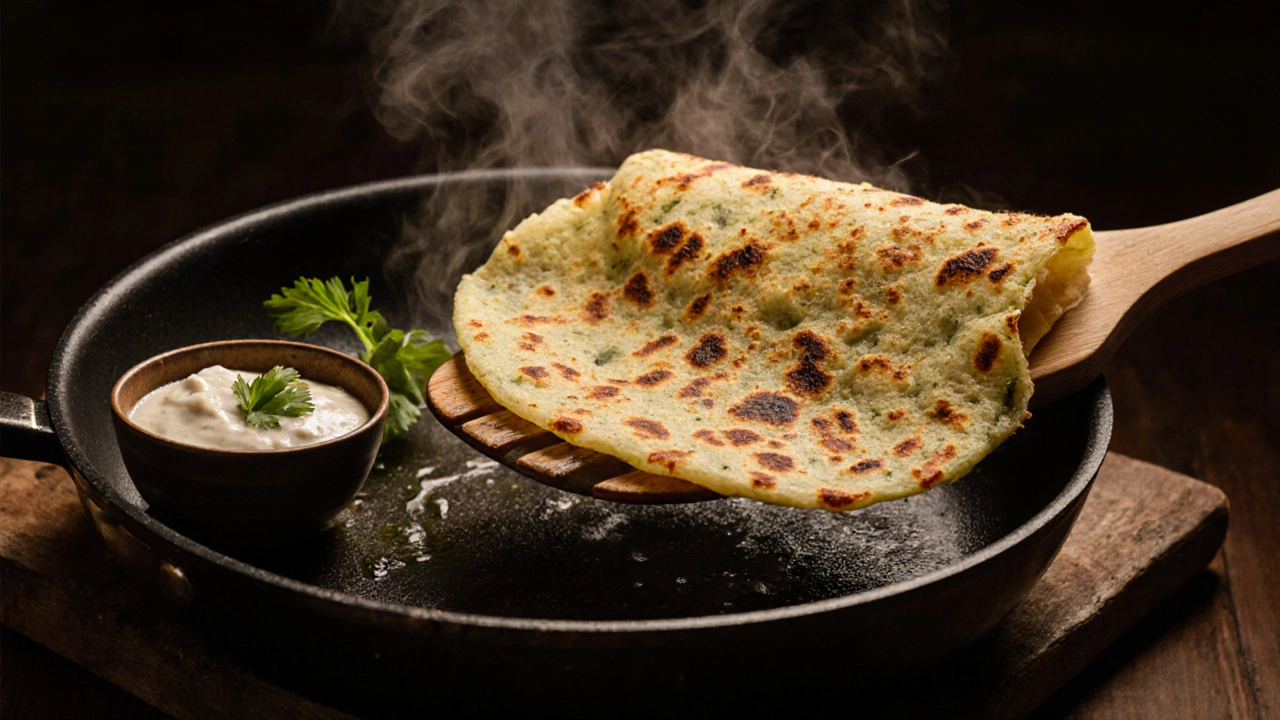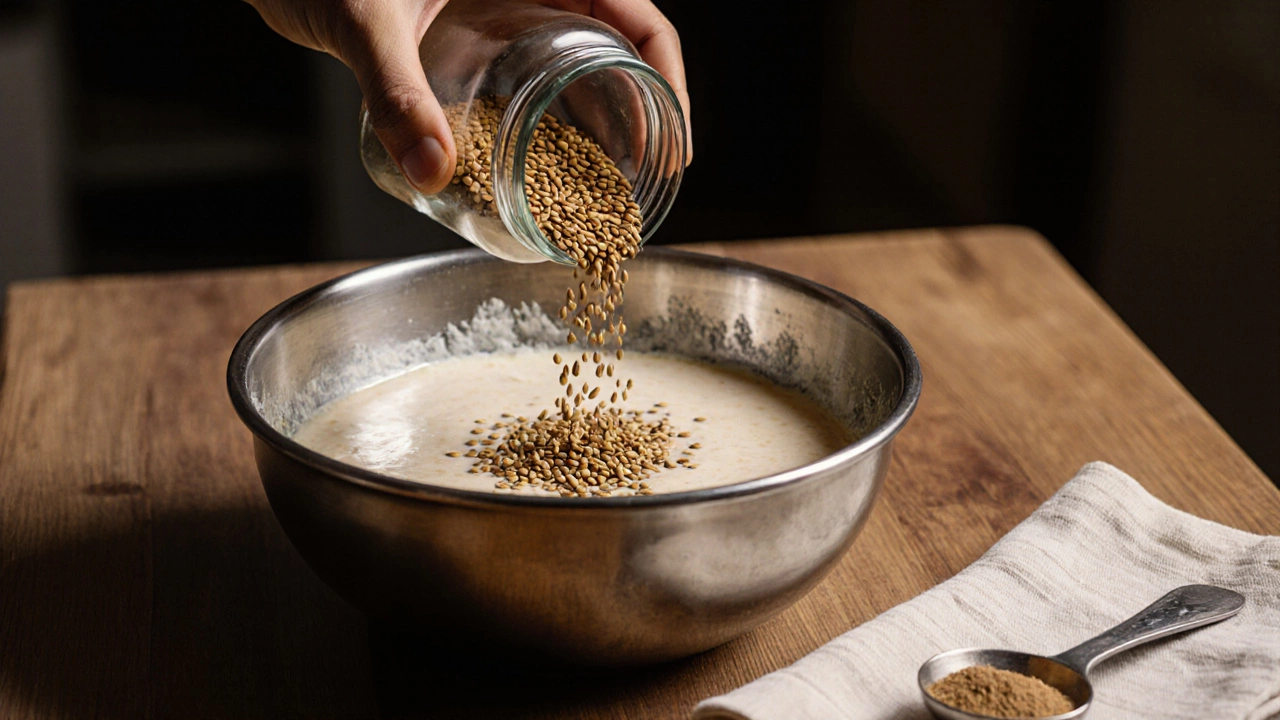22 Oct 2025
- 0 Comments
Fenugreek Measurement Calculator for Dosa Batter
This calculator helps you determine the optimal amount of fenugreek to add to your dosa batter based on the quantity of rice you're using. Using the right amount ensures perfect fermentation and flavor without excessive bitterness.
Input Parameters
Results
Results will appear here
Ever wondered why many South Indian households sprinkle a pinch of fenugreek into their dosa batter? The answer lies in a mix of chemistry, tradition, and nutrition. In this guide we break down the science behind the spice, the flavor boost it offers, and the practical tips you need to get perfect dosas every time.
What is Fenugreek?
Fenugreek is a leguminous herb (Trigonella foenum-graecum) whose seeds are earthy, slightly bitter, and aromatic. Its seeds have been used for centuries in Indian, Middle‑Eastern and Mediterranean cooking, as well as in traditional medicine. When ground into a fine powder or soaked whole, fenugreek releases soluble fibers, saponins, and a compound called 4‑hydroxy‑isoleucine that lends a sweet‑maple note.
Traditional Role of Fenugreek in South Indian Cooking
In the kitchens of Tamil Nadu, Karnataka, Kerala and Andhra Pradesh, fenugreek has a special place in the batter for idli, dosa and vada. Historically, the spice was added not just for taste but also to aid fermentation - a crucial step that turns a simple mixture of rice and lentils into a light, airy, probiotic‑rich batter.
How Fenugreek Changes Dosa Batter Chemistry
Fermentation is a dance between microorganisms (mainly Lactobacillus and yeast) and the starches in the batter. Fenugreek contributes in three key ways:
- Enzyme activation: The seed’s natural enzymes break down complex carbohydrates into simpler sugars, giving microbes more fuel.
- pH regulation: Fenugreek contains galactomannan, a soluble fiber that buffers the batter’s acidity, creating a stable environment for lactic‑acid bacteria.
- Carbon‑dioxide boost: By supplying extra fermentable sugars, the batter produces more CO₂, leading to a fluffier, crisper dosa.
In short, the addition of fenugreek turns a plain batter into a living system that rises higher and tastes brighter.
Flavor and Aroma Impact
Beyond the science, fenugreek adds a distinctive sweet‑bitter note that balances the sourness from fermentation. When the batter is cooked, the heat triggers Maillard reactions that amplify the nutty aroma, giving the final dosa a depth you won’t get from rice and urad dal alone.

Nutritional Boost
Fenugreek is a powerhouse of nutrients:
- Dietary fiber - up to 25 % of the seed weight, supporting digestion.
- Protein - about 23 % by weight, complementing the protein from urad dal.
- Vitamins - B‑complex (especially B6 and folate) and vitamin C.
- Minerals - iron, magnesium, manganese and potassium.
- Bioactive compounds - saponins and flavonoids that may help regulate blood sugar.
Adding a teaspoon of fenugreek to a batch that serves four people can increase the fiber content by roughly 2 grams and the iron by 5 % of the daily value.
How Much to Use and Practical Tips
Too much fenugreek can dominate the flavor, turning the batter overly bitter. Here’s a simple guideline:
- Whole seeds: ½ - 1 teaspoon per 2 cups of uncooked rice.
- Powdered: ¼ teaspoon per 2 cups of rice (adjust to taste).
For best results, soak the seeds in water for 4-6 hours, then grind them together with the rice and urad dal before fermentation. If you’re short on time, toast the seeds lightly to reduce bitterness, then grind.
Common Mistakes and How to Fix Them
- Over‑soaking: Leaves the batter too watery. Drain excess water before grinding.
- Skipping the resting period: The batter needs 8-12 hours at room temperature. A warm kitchen (around 28 °C) speeds up fermentation.
- Using stale fenugreek: Old seeds lose aroma and enzymatic activity. Store seeds in an airtight jar away from sunlight.
- Excess fenugreek: If the dosa tastes bitter, blend in a splash of plain yogurt or a pinch of sugar to balance.

Comparison of Fenugreek with Other Fermentation Aids
| Ingredient | Flavor Impact | Fermentation Effect | Typical Amount (per 2 cups rice) |
|---|---|---|---|
| Fenugreek seeds | Sweet‑bitter, nutty | Provides sugars & pH buffer | ½ - 1 tsp whole or ¼ tsp powder |
| Plain yogurt | Creamy, tangy | Speeds up lactic acid production | 2 tbsp |
| Sesame seeds | Nutty, mild | Adds little fermentable sugar | 1 tsp (optional) |
| Buttermilk | Lightly sour | Lowers pH quickly | 1‑2 tbsp |
While yogurt or buttermilk can jump‑start acidity, fenugreek is unique because it enhances flavor *and* supports a balanced microbial environment. That’s why many traditional recipes prefer it.
Putting It All Together - A Step‑by‑Step Dosa Batter Recipe with Fenugreek
- Rinse 2 cups of parboiled rice and ½ cup of split urad dal separately.
- Soak the rice, dal and ½ tsp whole fenugreek seeds together for 6 hours.
- Drain and grind to a smooth batter, adding a little water only if needed (the consistency should be pourable but not runny).
- Transfer to a large bowl, cover, and let ferment at 28 °C for 10 hours or until the batter doubles in volume and shows bubbles.
- Before cooking, stir gently and add a pinch of salt. Heat a non‑stick skillet, drizzle a few drops of oil, pour a ladle of batter, spread thin, and cook until golden brown on both sides.
The result? Crispy edges, a soft interior, and that signature hint of fenugreek that makes the dosa taste richer and more satisfying.
Frequently Asked Questions
Can I use fenugreek powder instead of whole seeds?
Yes. Use about one‑quarter teaspoon of powder for every 2 cups of rice. Powder integrates faster, but a tiny bit of bitterness may be more noticeable, so you might want to toast it lightly first.
Is fenugreek necessary for a good dosa?
Not strictly. Dosas will still turn out fine without it, but you’ll miss out on the extra fermentation boost, subtle maple‑like flavor, and added nutrition that fenugreek provides.
How long can I keep fenugreek‑infused batter in the fridge?
Stored in an airtight container, the fermented batter stays good for up to 4 days. The flavor may deepen, and the batter might become slightly more sour - a sign of continued fermentation.
Can I add fenugreek to gluten‑free dosa batter?
Absolutely. Fenugreek works the same way with rice‑only or millet‑based batters, helping them achieve a light texture even without urad dal’s protein.
What if my dosa turns flat after adding fenugreek?
Flat dosas often mean insufficient fermentation. Check the batter’s temperature, give it a few more hours, or add a pinch of sugar to feed the microbes.
Now that you know why fenugreek is a staple in dosa batter, go ahead and experiment. You’ll quickly see how a tiny pinch can transform texture, taste and health benefits, making every bite worth the effort.
